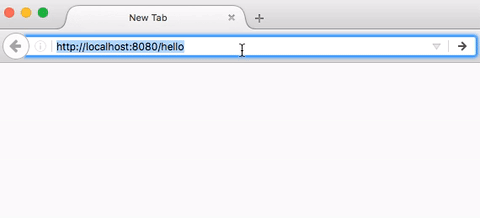This tutorial walks you through the steps of creating a Hello World web application example with Spring Boot and JSP
JSP stands for Jakarta Server Pages (aka JavaServer Pages). It is a server-side template engine helping create dynamic HTML web pages
What you'll build

What you'll need
JDK 8+ or OpenJDK 8+
Maven 3+
Your favorite IDE
Project structure
Following is the final project structure with all the files we would create
├── src
│ └── main
│ ├── java
│ │ └── com
│ │ └── hellokoding
│ │ └── springboot
│ │ └── view
│ │ ├── Application.java
│ │ └── HelloController.java
│ ├── resources
│ │ ├── static
│ │ │ ├── css
│ │ │ │ └── main.css
│ │ │ └── js
│ │ │ └── main.js
│ │ └── application.properties
│ └── webapp
│ └── WEB-INF
│ └── jsp
│ └── hello.jsp
└── pom.xml
pom.xml is the configuration file used by Maven to manage project dependencies and build process, it is usually placed in the project root directory
Web controller classes are used for mapping user requests to JSP files, would be created inside src/main/java
JSP view template files would be created inside src/main/webapp/WEB-INF/jsp
CSS and JavaScript files would be created inside src/main/resources/static
application.properties is a configuration file used by Spring Boot, would be created inside src/main/resources
Application.java is a launch file for Spring Boot to start the application, would be created inside src/main/java
Initialize a new Spring Boot application
Besides using IDE, we can create and init a new Spring Boot project by using Spring Initializr via web UI or command-line tools such as cURL, HTTPie, or Spring Boot CLI. Learn more about using these tools here
For getting started, we will choose Web and Devtools as dependencies. Below is an example with cURL
curl https://start.spring.io/starter.zip \
-d dependencies=web,devtools \
-d javaVersion=1.8 \
-d packageName=com.hellokoding.springboot \
-d groupId=com.hellokoding.springboot \
-d artifactId=hk-springboot-jsp \
-o hk-springboot-jsp.zip
Unzip the hk-springboot-jsp.zip file and import the sample project into your IDE
Project dependencies
For a Spring Boot JSP web application, we will need the following dependencies on the pom.xml file
spring-boot-starter-webprovides all the dependencies and auto-configuration we need to develop a web application in Spring Boot, including the Tomcat embedded servlet containertomcat-embed-jasperprovides the support for compiling JSP files in Tomcat
The library versions can be omitted as it will be resolved by the parent pom provided by Spring Boot
<dependency>
<groupId>org.springframework.boot</groupId>
<artifactId>spring-boot-starter-web</artifactId>
</dependency>
<dependency>
<groupId>org.apache.tomcat.embed</groupId>
<artifactId>tomcat-embed-jasper</artifactId>
</dependency>
Apart from that, we also use the spring-boot-devtools dependency to auto-trigger an application restart or live reload in the development environment whenever Java class or static files on class-path change, respectively. However, to leverage that, you need to configure your IDE to auto-save and auto-compile when files are modified
In the production environment, when a Spring Boot application is launched from a jar file, the devtools is auto disabled
<dependency>
<groupId>org.springframework.boot</groupId>
<artifactId>spring-boot-devtools</artifactId>
<scope>runtime</scope>
<optional>true</optional>
</dependency>
Create Controller
Create a Spring Boot controller file to map HTTP requests to JSP view files
[HelloController.java]
package com.hellokoding.springboot.view;
import org.springframework.stereotype.Controller;
import org.springframework.ui.Model;
import org.springframework.web.bind.annotation.GetMapping;
import org.springframework.web.bind.annotation.RequestParam;
@Controller
public class HelloController {
@GetMapping({"/", "/hello"})
public String hello(Model model, @RequestParam(value="name", required=false, defaultValue="World") String name) {
model.addAttribute("name", name);
return "hello";
}
}
The @Controller annotation indicates the annotated class is a web controller
@GetMapping maps HTTP GET request for "/" (home page) and "/hello" to the hello method
@RequestParam binds method parameter name to request query string parameter
Model is a Spring object for sharing data between handler and view template
The view template name is defined by the return statement of the handler and the spring.mvc.view.suffix config property which defined in the application.properties file. So in this hello handler method, the return view is hello.jsp
JSP View Template files
Create a simple JSP view template file to show a dynamic message to user
[hello.jsp]
<!DOCTYPE html>
<html lang="en">
<head>
<meta charset="UTF-8">
<title>Hello ${name}!</title>
<link href="/css/main.css" rel="stylesheet">
</head>
<body>
<h2 class="hello-title">Hello ${name}!</h2>
<script src="/js/main.js"></script>
</body>
</html>
The dynamic message is ${name}. It is an Java Expression Language enabling JSP files to access the data from the model. Its value is filled by the model.addAttribute("name", name); defined in the above HelloController
Static files
Create 2 simple CSS and JavaScript files inside /src/main/resources/static
The main.css file is linked into JSP view via <link href="/css/main.css" rel="stylesheet">
[main.css]
.hello-title{
color: darkgreen;
}
The main.js file is included into JSP view via <script src="/js/main.js"></script>
[main.js]
(function(){
console.log("Hello World!");
})();
Application Configurations
Create application.properties file inside src/main/resources to configure Spring MVC view resolver via the spring.mvc.view properties
[application.properties]
spring.mvc.view.prefix: /WEB-INF/jsp/
spring.mvc.view.suffix: .jsp
The spring.mvc.view.prefix property defines the path to JSP files, the spring.mvc.view.suffix property defines the file extension we would like to use
Under the hood, Spring Boot will auto-configure Spring MVC view resolver based on the above settings by using the following methods of WebMvcAutoConfiguration inside org.springframework.boot.autoconfigure.web.servlet package
[WebMvcAutoConfiguration.java]
@Bean
@ConditionalOnMissingBean
public InternalResourceViewResolver defaultViewResolver() {
InternalResourceViewResolver resolver = new InternalResourceViewResolver();
resolver.setPrefix(this.mvcProperties.getView().getPrefix());
resolver.setSuffix(this.mvcProperties.getView().getSuffix());
return resolver;
}
Run and Test
Create an Application class and use @SpringBootApplication annotation to launch the application
[Application.java]
package com.hellokoding.springboot.view;
import org.springframework.boot.SpringApplication;
import org.springframework.boot.autoconfigure.SpringBootApplication;
@SpringBootApplication
public class Application {
public static void main(String[] args) {
SpringApplication.run(Application.class, args);
}
}
Run the application by typing the following command on the terminal console at the project root directory
./mvnw clean spring-boot:run
You would see this text in the console
o.s.b.w.embedded.tomcat.TomcatWebServer : Tomcat started on port(s): 8080 (http) with context path ''
Access to http://localhost:8080 on your web browser, the following response is expected
Hello, World!
Try to modify the JSP, CSS, and JavaScript files, and refresh the browser, the HTML response would be updated accordingly thanks to the support from spring-boot-devtools
In a production environment, you may like to package and run the Spring Boot application as a single jar file
./mvnw clean package
java -jar target/hk-springboot-jsp-0.0.1-SNAPSHOT.jar
Conclusion
In this tutorial, we learned to create a Hello World web application in Spring Boot with JSP. The source code is available on Github
You may also like Spring Boot Tutorials in Practice
